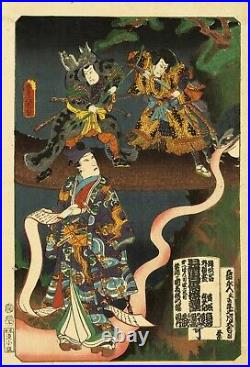
Date : 3rd year of Ansei. Detail: Binding hole / Slight soiling / Repair of a few foxing marks. The “Kodaraiya Gouketsu Tan” is an illustrated novel published from the 10th year of the Tempo Period. The character “Kodaraiya” was a fictional bandit and ninja who appeared in a late-Edo Period yomihon (a book read in the late Edo Period), and his activities as a magician who wields an echidna became the subject of many works as well as stories. Later, Tsunade, who wielded slugs, and his arch-enemy, Daijamaru, who wielded snakes at will, also appeared, and the story unfolded as a three-way struggle. Odori katagata gaitama jutaku is a series of kabuki plays depicting scenes from the past up to the time of their production. It is characterized by a vertical composition of a horizontal stage, and depicts many tall performances, such as staircases and midair rides. For performances that do not feature many tall staging, the composition is as if looking down from above, as if the viewer is looking down from the audience seats. One can see the author’s determination to convey the charm of the kabuki stage itself. Toyokuni III was a student of Toyokuni, who first took the name Kunisada, and in 1882 took the name Toyokuni II. In fact, Toyokuni II had already been succeeded by Toyoshige, but Toyokuni III took the name of Toyokuni II at that time, perhaps with the intention of making himself more suitable. Today, Toyokuni is treated as Toyokuni III for the sake of distinction. Toyokuni had a long period of painting, and it is thought that he produced more than 10,000 works. He was especially known for his depictions of people, including portraits of actors and beautiful women, and the number of his works and his vigor suggest that he dominated the Edo Ukiyoe world.
No comments